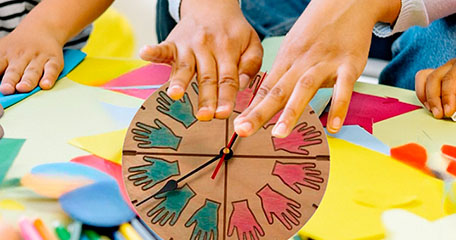Maths is everywhere!
| August 2024I’m Lynda Keith and in this article, I share creative ways to build children’s confidence in early mathematics. Maths goes way beyond numbers and playing with counting blocks. Let’s explore maths' many learning possibilities especially in your outdoor areas.
There can be little doubt that mathematics is all around us. From the moment children are born, they are surrounded by mathematical concepts. From the start of their day, they will likely follow a structured routine that includes specific times for tasks, conversations, and printed materials, all incorporating elements of maths.
Maths across the learning space
Early on in my career, my passion for boosting confidence in maths led me to champion specific maths areas with the same level of emphasis that construction or imaginative play spaces received. My perspective on early mathematical development shifted as I wrote my book, Developing Young Children’s Mathematical Learning Outdoors.
In my book, I focused on a more balanced view about the potential of maths across the entire learning space. I believe we need to look more closely at where maths is happening, how it is happening, and how we engage in quality discussions about the environment around us.
I realised that the outdoors is a huge playground for maths activities. It delivers a completely different context with a wide variety of materials and areas to explore. Being in nature is a wonderful way to integrate maths with other key developmental skills and it’s the perfect setting to encourage discussion and curiosity.
There is no need to prepare formal mathematical lessons; your outdoor space has plenty of resources. For example, a child climbing a tree or frame will have to think about spacing and distance. This in turn tunes in their problem-solving skills, language skills and physical capabilities. Being outside also means you can incorporate outdoor materials like leaves, sticks or rocks, into collecting and sorting activities.
Twelve indicators for maths outdoors
I get asked a lot of questions about how to create an environment that fosters fun and creativity in maths development, so I wrote 12 indicators for maths outdoors which share ways to create an environment that can bring maths into every part of learning and play.
Does your outdoor space:
- Have flexible areas to give children the freedom to explore their own mathematical ideas?
- Contain modular resources, so children can make connections and compare relationships?
- Foster decision-making essential for later mathematical thinking?
- Offer problem-solving opportunities and chances to develop curiosity?
- Enable children to make sense of the mathematical world around them?
- Motivate children to count, measure and compare?
- Offer spaces where children can engage in mathematical processes and early thinking skills?
- Offer opportunities to develop mathematical skills across different areas?
- Present places for fun challenges that promote active thinking about maths and numeracy?
- Contain opportunities for multisensory learning? Young children should use all of their senses to explore the mathematical world around them.
- Include areas that promote mathematical graphics and recording? (Mark making materials to help children to make sense of symbols in their play).
- Contain open-ended resources to support all aspects of mathematical learning?
An example: mud kitchen maths
What is the continuous provision for maths in your mud kitchen? How and where are your children incorporating maths into their play in this area? Are they:
- Engaging in role play using mathematical language in context: Do you have enough? Do you need more? How much more do we need? Is there a ‘cake’ in every section of the cake tin?
- Developing thinking skills and reasoning through filling, emptying, sharing, adding water, and changing consistency and noticing the differences in substance.
- Developing the concept of more/less/enough/not enough (leads to discussion about quantity or comparisons of amount).
- Sorting utensils according to their functions and being creative in using tools for different purposes.
- Moving and transporting, making decisions about how to carry, where to carry, and the difficulties in carrying something too heavy.
- Developing possibility through thinking and asking, “What if….?” or “I wonder what could happen…?” questions.
- Sequencing and ordering, making comparisons and using mathematical language to describe what they have found out.

Possible resources for your mud kitchen:
| Tools | Containers | Materials | Provocations |
|---|---|---|---|
|
spoons straws scoops forks ladles tongs whisks spades pestle and mortar scales for weighing |
bowls buckets pots sieves pans plates colander scoops tubs jugs bottles baking trays tins |
metal wood plastic sticks shells conkers mud plants leaves leaves gravel pebbles |
'recipe' books laminated pictures |
In conclusion
It’s often thought that maths and play are at two opposite ends of the spectrum; one has traditionally been full of rules, and the other is more about imaginative fun. However, for young children, maths and play have a lot in common and it’s essential to integrate them, both indoors and outdoors.
With a balanced learning environment and positive encouragement, we can make maths a fun part of children’s everyday world.
References
Mark Making Matters: Young children making meaning in all areas of learning and development’ by the Department for children, schools and families (DfES).
Keith, Lynda. Developing Young Children’s Mathematical Learning Outdoors. London: Routledge. 2018










